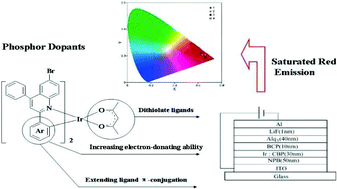Tuning the saturated red emission: synthesis, electrochemistry and photophysics of 2-arylquinoline based iridium(iii) complexes and their application in OLEDs†
Abstract
A series of novel iridium(III) complexes with two 2-arylquinoline derivatives as cyclometalated ligands and one monoanionic ligand, such as acetylacetonate (acac), N,N′-diethyldithiocarbamate (Et2dtc) and O,O′-diethyldithiophosphate (Et2dtp), as ancillary ligands have been synthesized and structurally characterized by 1H NMR, MS and elemental analysis (EA). The cyclic voltammetry, absorption, emission and electroluminescence properties of these complexes were systematically investigated. Through extending π-conjugation, introducing electron-donating groups in the ligand frame, or changing the ancillary ligands, the HOMO energy levels of the iridium(III) complexes can be tuned, while their LUMO levels remain little affected; in consequence, the emission wavelengths of the iridium(III) complexes can be tuned in the range 606–653 nm. The highly efficient organic light-emitting diodes (OLEDs) with saturated red emission have been demonstrated. A maximum current efficiency of 10.79 cd A−1, at a current density of 0.74 mA cm−2, with an emission wavelength of 616 nm and Commisioon Internationale de L'Eclairage (CIE) coordinates of (0.65, 0.35), which are very close to the National Television System Comittee (NSTC) standard red emission, have been achieved when using complex (DPQ)2Ir(acac) as a phosphor dopant.


 Please wait while we load your content...
Please wait while we load your content...